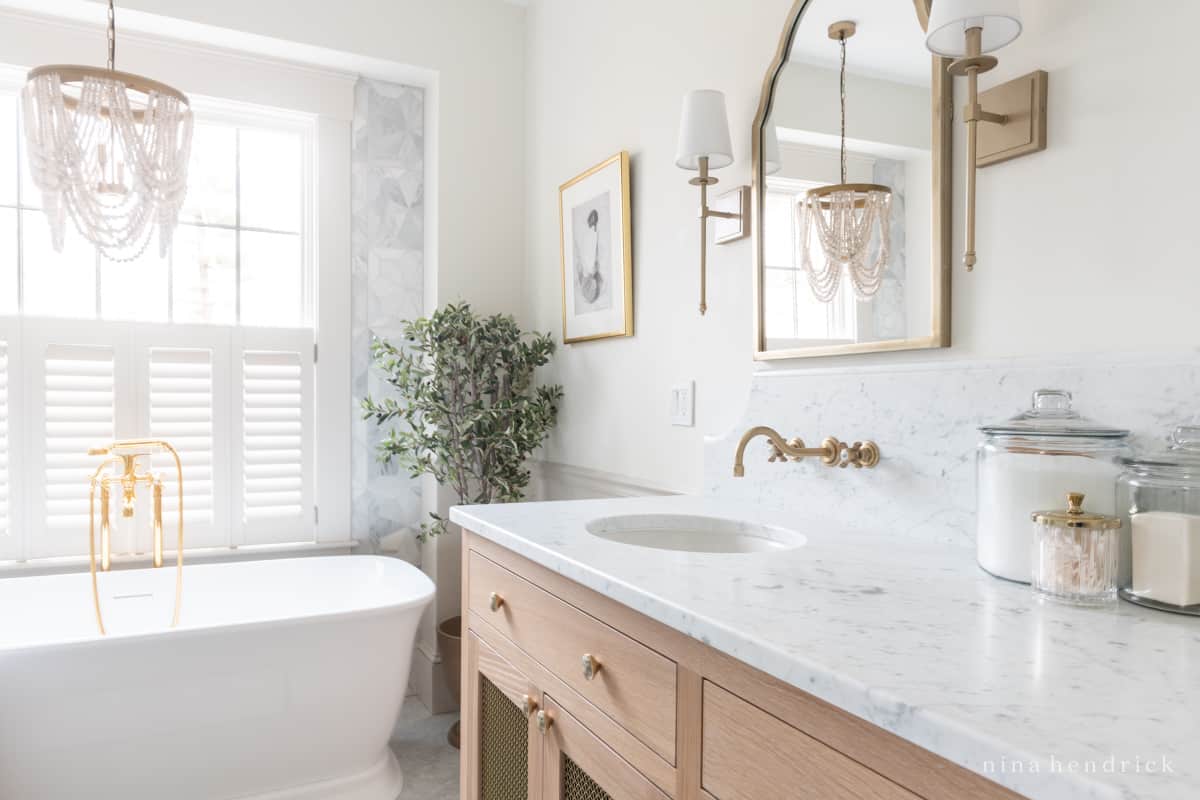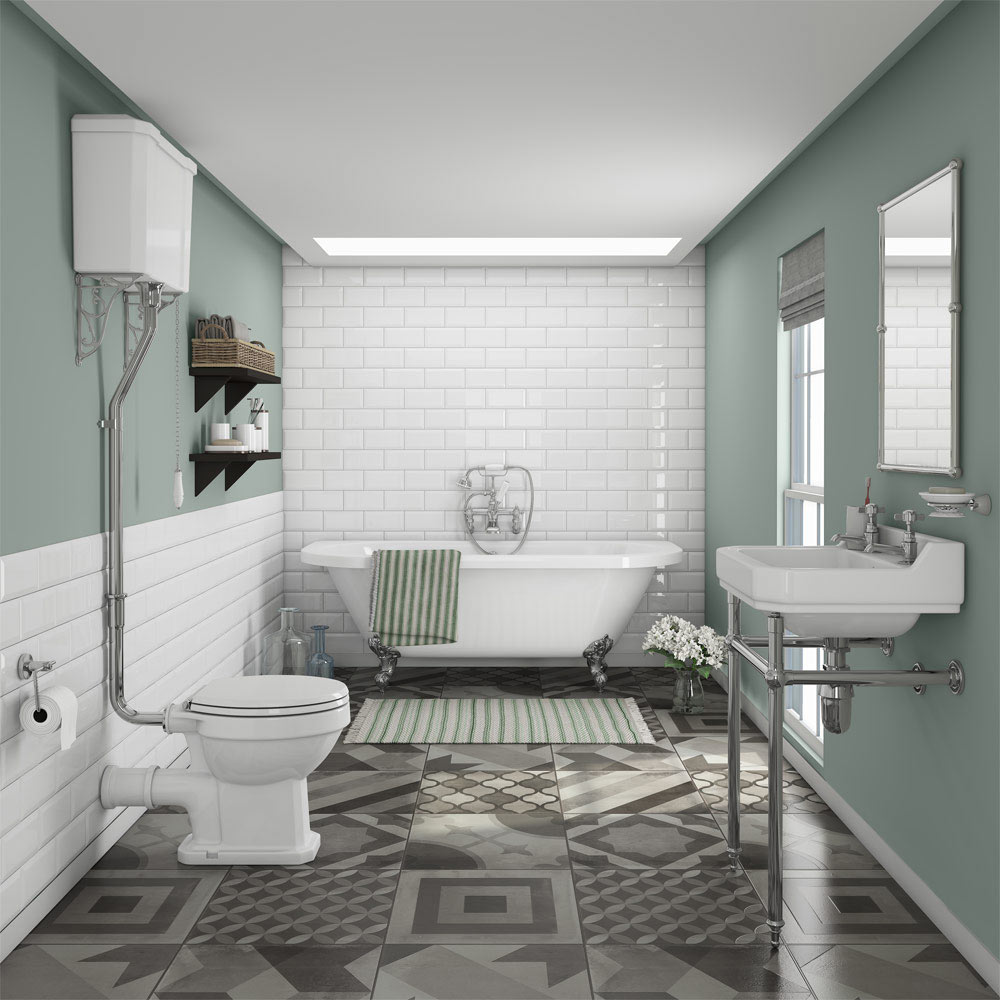Defining Traditional Bathroom Design

Traditional bathroom design embodies a timeless aesthetic that draws inspiration from historical styles and architectural elements. It evokes a sense of comfort, elegance, and enduring appeal, often characterized by intricate details, rich materials, and a focus on functionality.
Historical Influences and Evolution
Traditional bathroom design has evolved over centuries, reflecting the changing tastes and technological advancements of each era.
- Victorian Era (1837-1901): This period saw a rise in elaborate bathroom fixtures, such as clawfoot tubs, ornate vanities, and decorative tiles. The emphasis was on creating opulent and luxurious spaces.
- Art Deco (1920s-1930s): Art Deco brought geometric patterns, bold colors, and streamlined designs to bathroom decor. Chrome fixtures and geometric tile patterns became popular elements.
- Mid-Century Modern (1940s-1960s): This era favored clean lines, functional designs, and natural materials. Bathrooms featured simple vanities, minimalist fixtures, and a focus on practicality.
- Contemporary Traditional (Present): Modern traditional bathrooms combine classic elements with contemporary updates. This style often features traditional fixtures and finishes with a more minimalist approach.
Prominent Architects and Designers
Several renowned architects and designers have contributed significantly to the development of traditional bathroom aesthetics:
- Frank Lloyd Wright: Wright’s emphasis on natural materials and organic forms influenced bathroom design, incorporating elements like wood, stone, and built-in fixtures.
- Charles Rennie Mackintosh: Mackintosh’s designs, known for their geometric patterns and minimalist approach, influenced the Art Deco style and contributed to the development of streamlined bathroom fixtures.
- Philip Johnson: Johnson’s work, characterized by its use of glass and steel, influenced the development of modern traditional bathroom design, where classic elements are combined with contemporary materials.
Essential Elements of Traditional Bathroom Design

A traditional bathroom design evokes a sense of timeless elegance and sophistication, drawing inspiration from classic architectural styles and incorporating elements that create a warm, inviting, and enduring atmosphere. Key elements contribute to this distinctive aesthetic, shaping the overall look and feel of the space.
Color Palette
The color palette in a traditional bathroom often revolves around a foundation of neutral tones, providing a sense of calm and serenity. These serve as a backdrop for the introduction of warm colors, which add depth and richness to the design.
- Neutral Tones: White, cream, beige, gray, and soft blues are frequently used as primary colors, creating a sense of spaciousness and allowing other design elements to stand out.
- Warm Colors: Subtle accents of warm colors like soft greens, browns, and golds can be incorporated through paint, tile, or accessories, adding warmth and character.
- Natural Materials: The use of natural materials like wood and stone in their natural hues further enhances the traditional aesthetic, bringing in a sense of authenticity and grounding the design.
Materials
The materials used in a traditional bathroom are carefully chosen to complement the overall design and create a sense of durability and timeless elegance.
- Natural Stone: Marble, granite, limestone, and travertine are commonly used for countertops, floors, and walls, adding a touch of luxury and sophistication. Marble, known for its elegant veining, is often favored for countertops and floors, while granite’s durability makes it suitable for high-traffic areas. Limestone and travertine offer a more rustic and textured look.
- Wood: Oak, cherry, and mahogany are popular choices for cabinets, vanities, and trim, bringing warmth and a sense of natural beauty to the space. Oak, with its robust grain, provides a classic and enduring look, while cherry and mahogany add a touch of richness and sophistication.
- Metal: Brass, bronze, and nickel are commonly used for fixtures, hardware, and accents, adding a touch of warmth and elegance. Brass and bronze fixtures offer a warm, traditional aesthetic, while nickel provides a more contemporary and polished look.
- Ceramics: Porcelain and tile are used extensively in traditional bathrooms for floors, walls, and backsplashes. Porcelain tiles offer durability and elegance, while ceramic tiles provide a more affordable option with a wide range of colors and patterns.
Fixtures
Traditional bathroom fixtures are characterized by their classic designs and enduring quality, often featuring intricate details and a focus on functionality.
- Clawfoot Tubs: A hallmark of traditional bathroom design, clawfoot tubs offer a sense of indulgence and create a focal point in the space. Their elegant curves and ornate feet add a touch of grandeur and sophistication.
- Pedestal Sinks: Pedestal sinks provide a streamlined and elegant look, minimizing visual clutter and creating a sense of openness. Their classic design complements the traditional aesthetic, while their exposed plumbing adds a touch of vintage charm.
- Ornate Faucets: Traditional bathroom faucets often feature intricate details, such as cross handles, lever handles, and decorative spouts. These details add a touch of elegance and sophistication, reflecting the craftsmanship of the past.
Lighting, Traditional home bathroom design
Lighting plays a crucial role in creating the desired ambiance in a traditional bathroom, enhancing the space’s elegance and functionality.
- Chandeliers: Chandeliers, with their ornate designs and multiple light sources, add a touch of grandeur and sophistication to the bathroom, creating a statement piece and illuminating the space with soft, warm light.
- Sconces: Sconces, mounted on the walls, provide focused lighting for specific areas, such as the vanity or bathtub, while also adding a decorative element to the design. Their classic styles complement the traditional aesthetic and create a warm, inviting atmosphere.
- Natural Light: Maximizing natural light through windows is essential in a traditional bathroom, bringing in a sense of openness and brightness, enhancing the space’s airy feel and highlighting the natural materials used in the design.
Decorative Details
Decorative details play a crucial role in creating a cohesive and inviting atmosphere in a traditional bathroom, adding personality and depth to the design.
- Moldings: Crown molding, chair rails, and wainscoting add architectural interest and create a sense of formality, defining the space and adding visual appeal.
- Hardware: Knobs, pulls, towel bars, and other hardware should complement the overall design, often featuring classic styles with intricate details. These details can add a touch of elegance and sophistication, reflecting the craftsmanship of the past.
- Mirrors: Ornate frames and antique-style mirrors add a touch of vintage charm and elegance to the bathroom, reflecting the space and creating a sense of depth. Mirrors with intricate carvings or decorative borders complement the traditional aesthetic and enhance the overall design.
- Accessories: Rugs, towels, and artwork can be used to add color, texture, and personality to the bathroom. Choose accessories that complement the traditional aesthetic, such as floral patterns, vintage-inspired prints, or natural materials.
Modern Interpretations of Traditional Bathroom Design: Traditional Home Bathroom Design

Contemporary designers are breathing new life into traditional bathroom design, seamlessly blending classic elegance with modern sensibilities. This approach creates spaces that are both timeless and contemporary, appealing to a wide range of tastes.
Modern Interpretations of Traditional Bathroom Design Elements
Modern interpretations of traditional bathroom design involve incorporating classic elements in a way that feels fresh and updated. This often involves simplifying lines and forms, utilizing modern materials and finishes, and integrating modern technology.
| Traditional Element | Modern Interpretation | Example | Image Description |
|---|---|---|---|
| Ornate Moldings | Simplified Moldings | A bathroom with sleek, minimalist moldings around the ceiling and walls, creating a clean and contemporary look. | A bathroom with white walls and a white ceiling. The ceiling has a thin, rectangular molding around the perimeter. The walls have a thin, rectangular molding around the baseboard and a slightly thicker molding around the window and door frames. |
| Clawfoot Tubs | Freestanding Tubs with Modern Lines | A freestanding tub with a minimalist design and clean lines, placed in the center of the bathroom. | A white, freestanding bathtub with a rectangular shape. The tub has a smooth, curved edge and sits on a pedestal base. The bathroom has a white tile floor and white walls. |
| Chandeliers | Modern Lighting Fixtures | A bathroom with a sleek, geometric pendant light fixture over the vanity, adding a touch of modern sophistication. | A bathroom with a white vanity and a large mirror. Above the vanity hangs a pendant light fixture made of brushed nickel and glass. The fixture has a geometric shape and a modern design. |
| Dark Wood Cabinets | Light Wood or Lacquered Cabinets | A bathroom with light wood cabinets that create a sense of spaciousness and airy feel. | A bathroom with a light wood vanity with a white countertop. The vanity has a simple design with clean lines. The bathroom has a white tile floor and white walls. |
| Floral Wallpaper | Geometric or Abstract Wallpaper | A bathroom with a geometric patterned wallpaper that adds a touch of visual interest and modern flair. | A bathroom with white walls and a geometric patterned wallpaper in shades of gray and white. The wallpaper features a repeating pattern of squares and triangles. |
Traditional home bathroom designs often emphasize simplicity and functionality, with a focus on natural materials like wood and stone. This aesthetic extends to the wash basin, where a variety of designs have evolved to meet both practical and aesthetic needs.
Exploring bathroom wash basin designs in India reveals a fascinating blend of traditional craftsmanship and modern innovation, offering a range of styles from ornate hand-carved basins to sleek contemporary designs. Whether embracing a classic or modern approach, the wash basin remains a focal point in any bathroom, reflecting the overall design theme and personal style.
Traditional home bathroom design often features classic elements like clawfoot tubs and ornate mirrors. But even with these timeless fixtures, a modern touch can be achieved through a simple bathroom vanity makeover with chalk paint. By refreshing the vanity with a new color and finish, you can seamlessly blend modern style with the enduring charm of traditional design.
